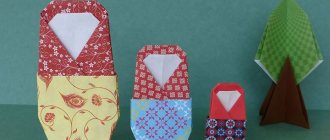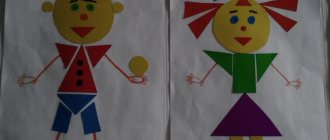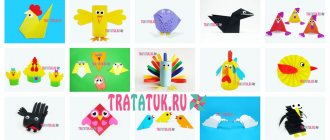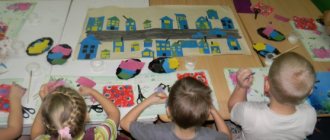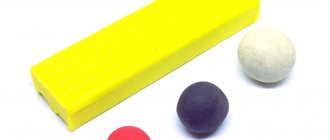Applications for advanced
All creative tasks develop imagination in children and adults, a craving for handicrafts and art. When we learn to make appliqués with our own hands, then, as with any task, we can approach the matter precisely and strictly “as per the manual,” or we can add elements of play and even mischief.
To further involve your child in the process, use other, non-standard materials in addition to paper:
- Thick knitting threads that can be woven into braids are well suited for hair;
- For hairstyles and beards - cotton wool;
- To depict clothes, you can mix different materials: paper and fabric, glitter, paper curls;
If you have mastered paper applique, you can safely move on to other types: appliques made from beads, from seeds, from autumn natural materials.
The main thing is that children and adults enjoy this process.
Application of a man in motion
The next level of complexity is considered to be the appliqué of a person in motion. This application for children will seem more painstaking and will require their concentration.
But, in addition to basic skills, it will allow children to study the structure of the body, the names of poses and directions of movements. The basis of this technique is the application of a person from geometric shapes.
This time you will need to make more smaller pieces:
- The arms and legs are depicted from two thin rectangles;
- The human torso is a square or rectangle;
- The head is a smaller square or circle;
For clarity, you can always offer the child a basis from which he can start and continue to act independently: for example, glue torso figures for two people at once onto a piece of paper, and invite the child to glue his hands so that the figures are in different poses.
Of course, all the names of the poses need to be voiced and shown to the baby by example. As experience accumulates, the child will be able to create compositions from several figures depicting active ball games, physical education lessons, swimming, dancing and many other movements familiar to him.
Application of a person's face made of paper
Having seriously studied body parts and geometric shapes, you can distract yourself a little and do more creative things - applique of the human face.
Here the child gets more space for imagination and enjoys studying not only the parts of the face and their names, but also practices using facial expressions to distinguish and show different emotions.
As with other applique techniques, parents need to talk about the face, sensory organs and their functions, show them to the baby on the body and discuss their position relative to each other.
On a sheet of paper, you should mark the outline of the face with a pencil, or prepare a circle or oval from paper, which will become the basis of the face and the rest of the elements will be placed on it.
You should try to prepare several variations of facial elements in advance:
- Different eye colors and sizes;
- Eyebrows of different shapes
- Several nose options;
- Several smiles expressing different emotions;
- Ears of different sizes and shapes;
- Hair: hairstyles for boys and girls;
- Additional accessories (bow, hat, etc.).
In the process of making the applique, it is better to help the child stick the base face onto a sheet of paper and place the eyes correctly on the face - they will become a reference point for the baby, relative to which all other elements of the face need to be positioned.
By gluing eyebrows above the eyes, a nose in the center of the face, ears parallel to the eyes, the child learns the basics of symmetry and proportions. Several stencil options will add an element of play and fun to this process.
A beautiful applique will not only delight your baby, but will also immerse him deeper into the world of creativity.
Summary of OOD on application in the second junior group on the topic: “Stick on whatever toy you want”
Abstract of OOD on application in the second junior group on
topic: “Stick on whatever toy you want”
Target:
continue to introduce children to round objects.
Tasks:
Learn the techniques of gluing, spreading glue on the back of the form, pressing the forms to the paper with a napkin and your entire palm.
Cultivate a sense of empathy.
Material:
toys: Red Dog, (tumbler, ball, caterpillar)
Multi-colored circles of different sizes, album sheets, glue, napkins for each child.
Connections with other activities and activities.
Games with toys; clarification of the shape, structure, color of toys.
Progress of the lesson:
Educator: -
Guys, I just received a text message that our friend Red Dog, whom we know from our song “The Steam Locomotive is Coming,” is coming to us now! He's in trouble! He went to visit his neighbors and wanted to give them toys, but when he was racing on his little train, the last carriage went off the rails and overturned! And all the toys fell apart! He asks us to help him collect his toys!
Educator:
- Guys, let's sing a song about him while we wait for our friend?!
Children:
- Let's.
Performing the song “The Locomotive is Riding, the Locomotive is Riding” (Red Dog appears)
Ginger dog:
- Hello guys!
Educator:
- Hello, Red Dog!
Educator:
We read your SMS. Don’t be upset, the guys and I will definitely help you collect the toys! Really, guys?
Children:
Yes!
Educator:
- Guys, these are the toys our Doggie was carrying, and this is what’s left………… (
the teacher shows the toys: a tumbler, a ball, a caterpillar)
- Please tell me what shape they are?
Children:
- Round shape.
Educator:
- What shape is this colored paper?
(The teacher shows circles of different sizes and colors)
Children:
- Round.
(remember and pronounce colors)
Educator:
- What is the difference?
Children:
- some circles are small, others are large, and of different colors.
Educator:
- Guys, do you want us to make toys for our Doggie out of circles?
Children: -
We want!
(The teacher shows on a flannelgraph how to connect the circles, the children guess what toy it looks like)
Educator: -
Guys, do you know that toys are magical, that when we go to bed, they begin their own lives? You will see this now!
Physical education “Funny toys”
Here is a big pyramid
(reach up)
And a cheerful ringing ball
(jumping in place)
A soft bear with club feet
(steps in place, on the outside of the foot)
Everyone lives in the same box
(show the big square)
But when I go to bed
(hands under cheek, close eyes)
Everyone starts to play
(depict any movement)
We are funny cuties
(hands on the belt, swing to the sides)

